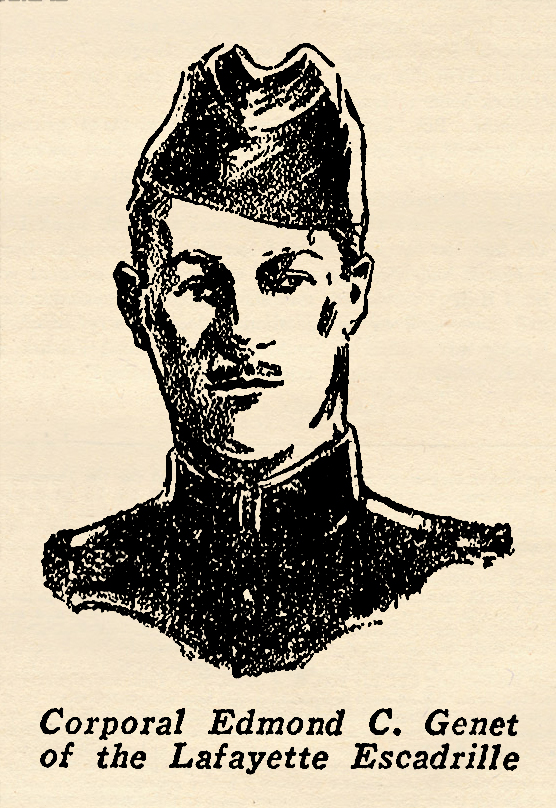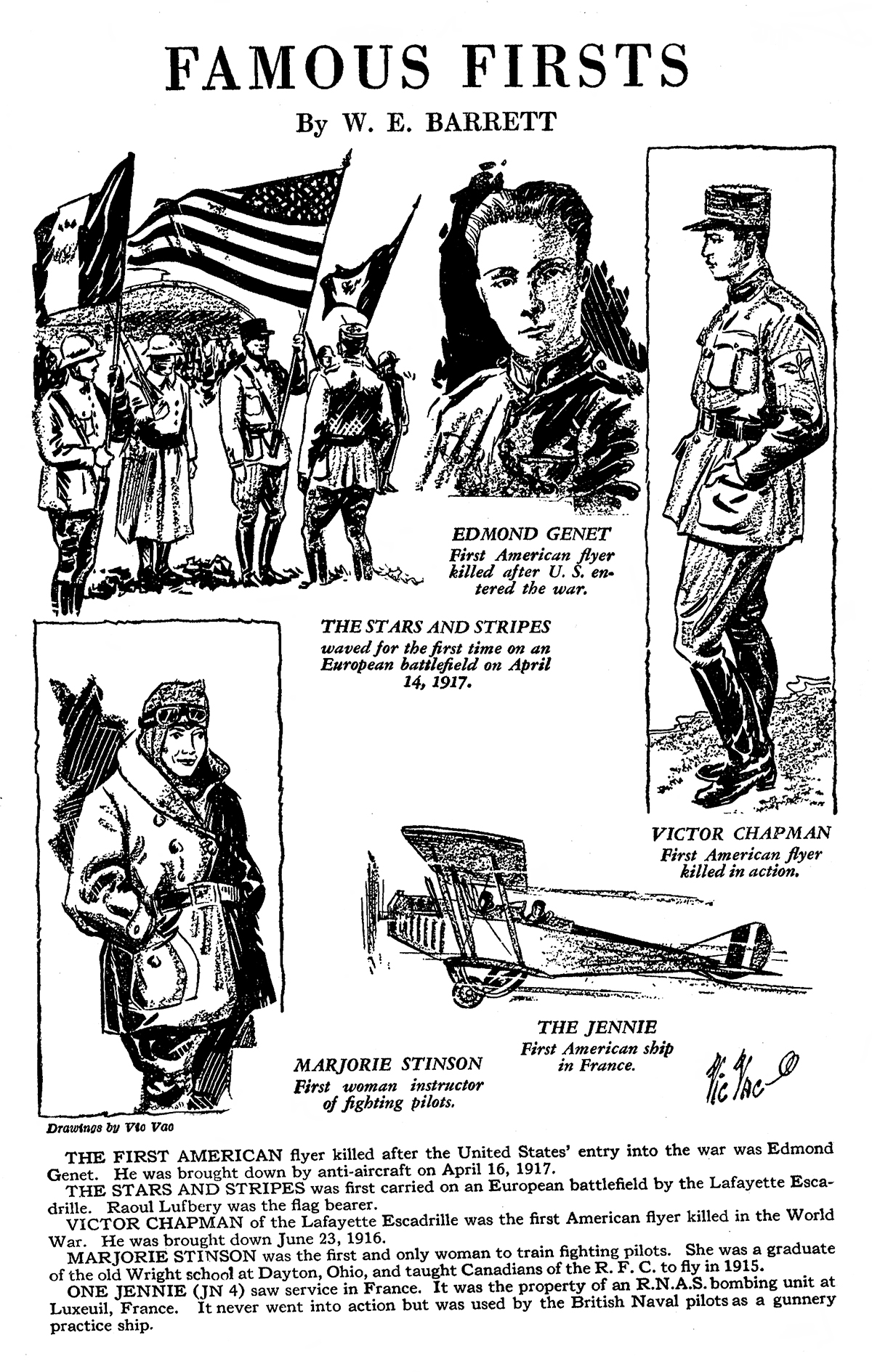Amidst all the great pulp thrills and features in Sky Fighters, they ran a true story feature collected by Ace Williams wherein famous War Aces would tell actual true accounts of thrilling moments in their fighting lives! This time we have American Flyer Corporal Edmond C. Genet’s most thrilling sky fight!
The great-great-grandson of  Citizen Genet, who served as the revolutionary ambassador from France during George Washington’s term as president, Edmond C. Genet had a distinguished heritage. Mild-mannered and handsome he was a typical soldier of fortune at heart, possessing an astonishing courage. At 10 he missed an appointment to Annapolis and immediately enlisted in the navy where he participated in the taking of Vera Cruz. A year later he was in battle in Haiti. Later on after the war in Europe broke out, he sailed for France to enlist in the Foreign Legion. He served for some years in the trenches as a simple poilu, then was transferred to aviation and assigned to Escadrille N-124, better known as the Lafayette, where he was the youngest American in a company of famous men. Genet’s flying time on the front was short. He was one of the few airplane pilots to be killed in the air by enemy shrapnel. He was the first American to die in action under the stars and stripes, his death occurring just ten days after America entered the war. The account below is from one of his letters home.
Citizen Genet, who served as the revolutionary ambassador from France during George Washington’s term as president, Edmond C. Genet had a distinguished heritage. Mild-mannered and handsome he was a typical soldier of fortune at heart, possessing an astonishing courage. At 10 he missed an appointment to Annapolis and immediately enlisted in the navy where he participated in the taking of Vera Cruz. A year later he was in battle in Haiti. Later on after the war in Europe broke out, he sailed for France to enlist in the Foreign Legion. He served for some years in the trenches as a simple poilu, then was transferred to aviation and assigned to Escadrille N-124, better known as the Lafayette, where he was the youngest American in a company of famous men. Genet’s flying time on the front was short. He was one of the few airplane pilots to be killed in the air by enemy shrapnel. He was the first American to die in action under the stars and stripes, his death occurring just ten days after America entered the war. The account below is from one of his letters home.
HOLDING THE HUNS AT BAY
by Corporal Edmond C. Genet • Sky Fighters, December 1934
I WAS flying along with McConnell at a very low altitude behind the German lines. Mac and I were making a survey of the enemy troop concentration. Intelligence had brought word that the Germans were preparing for a push in our area. We were to check on this, and as the country was hilly and wooded, we had to fly low to make the proper observations.
Being so engrossed with our ground work, both of us had neglected to watch the sky lanes. Suddenly we were jumped by a whole flight of Huns who took us completely by surprise! A burst of Spandau lead crackled through my plane from the rear! I glanced back, saw three Huns on me, throwing lead! At the same instant my right cheek began to sting and something scorched across my hip.
I swept up on one wing tip, whirled around. Two other Hun planes confronted me there. Their Spandaus were smoking. I looked over at McConnell, waved at him to go on with the mission while I attempted to hold off the Huns. I thought I could hold them off by making a bold, dashing frontal attack at first one, then the other. Mac banked off and swept down lower toward the ground.
I charged my first Hun with Vickers chattering. He turned aside and I plunged for the next. The second Hun clung to me and we began going round and round ineffectively. But a third Hun from above dived down, raked my turtleback with tracer. I was forced to pull out, but did not run away. I sneaked further inside the German lines drawing the Hun planes with me.
They had apparently forgotten Mac. Our strategy had been successful so far, but I wasn’t so sure that I was going to figure in the picture much longer. For the Huns had the speed on me and it was only a matter of minutes before I was entirely surrounded again. Bullets came from all directions at once. I was cornered. There was nothing to do but fight my way out boldly.
I dived for speed, then zoomed at my nearest antagonist. My tracer raked across his nose, puffed holes in his upper wing. He rolled off to one side to let me pass, for I was determined I would not turn out for him. That gave me an opening and I streaked through with the whole flight of Huns after me.
Presently I was rejoined by Mac, and what a relief! He was smiling, so I knew he had finished his mission successfully. We fought clear back to our lines where the Huns left us. I had just enough strength left to set down on the squadron drome safely, but my squadron mates had to lift me from my seat. It was a hot fight, but Mac and I got what we went out after—information that enabled our corps commander to forestall the German push!








 Citizen Genet, who served as the revolutionary ambassador from France during George Washington’s term as president, Edmond C. Genet had a distinguished heritage. Mild-mannered and handsome he was a typical soldier of fortune at heart, possessing an astonishing courage. At 10 he missed an appointment to Annapolis and immediately enlisted in the navy where he participated in the taking of Vera Cruz. A year later he was in battle in Haiti. Later on after the war in Europe broke out, he sailed for France to enlist in the Foreign Legion. He served for some years in the trenches as a simple poilu, then was transferred to aviation and assigned to Escadrille N-124, better known as the Lafayette, where he was the youngest American in a company of famous men. Genet’s flying time on the front was short. He was one of the few airplane pilots to be killed in the air by enemy shrapnel. He was the first American to die in action under the stars and stripes, his death occurring just ten days after America entered the war. The account below is from one of his letters home.
Citizen Genet, who served as the revolutionary ambassador from France during George Washington’s term as president, Edmond C. Genet had a distinguished heritage. Mild-mannered and handsome he was a typical soldier of fortune at heart, possessing an astonishing courage. At 10 he missed an appointment to Annapolis and immediately enlisted in the navy where he participated in the taking of Vera Cruz. A year later he was in battle in Haiti. Later on after the war in Europe broke out, he sailed for France to enlist in the Foreign Legion. He served for some years in the trenches as a simple poilu, then was transferred to aviation and assigned to Escadrille N-124, better known as the Lafayette, where he was the youngest American in a company of famous men. Genet’s flying time on the front was short. He was one of the few airplane pilots to be killed in the air by enemy shrapnel. He was the first American to die in action under the stars and stripes, his death occurring just ten days after America entered the war. The account below is from one of his letters home.